A Comparison of Several UAV-Based Multispectral Imageries in Monitoring Rice Paddy (A Case Study in Paddy Fields in Tottori Prefecture, Japan)
Abstract
1. Introduction
- (1)
- Confirmation of the relationship between the growth parameters of rice paddy and the vegetation index: Temporal observations using UAV-based multispectral cameras are conducted on a rice paddy, and then clarify the relationship between the observed data, physiological and ecological information.
- (2)
- Recommendation of monitoring the growth process of rice paddy: By identifying the optimum index for monitoring the growth process of paddy rice, we propose a reasonable method for rice paddy growth monitoring.
2. Materials and Methods
2.1. Study Site
2.2. Multispectral UAV Images Acquisition
2.3. Image Processing and Index Analysis
3. Results
3.1. Comparison of Multispectral Cameras
3.2. Comparison of Various Vegetation Indices
4. Discussion
5. Conclusions
Author Contributions
Funding
Institutional Review Board Statement
Informed Consent Statement
Data Availability Statement
Acknowledgments
Conflicts of Interest
References
- Weiss, M.; Jacob, F.; Duveiller, G. Remote sensing for agricultural applications: A meta-review. Remote Sens. Environ. 2020, 236, 111402. [Google Scholar] [CrossRef]
- Sishodia, R.P.; Ray, R.L.; Singh, S.K. Applications of Remote Sensing in Precision Agriculture: A Review. Remote Sens. 2020, 12, 3136. [Google Scholar] [CrossRef]
- Zhang, C.; Kovacs, J.M. The application of small unmanned aerial systems for precision agriculture: A review. Precis. Agric. 2012, 13, 693–712. [Google Scholar] [CrossRef]
- Singh, K.; Frazier, A.E. A meta-analysis and review of unmanned aircraft system (UAS) imagery for terrestrial applications. Int. J. Remote Sens. 2019, 39, 5078–5098. [Google Scholar] [CrossRef]
- Maes, W.H.; Steppe, K. Perspectives for Remote Sensing with Unmanned Aerial Vehicles in Precision Agriculture. Trends Plant Sci. 2019, 24, 152–164. [Google Scholar] [CrossRef] [PubMed]
- Hama, A.; Tanaka, K.; Chen, B.; Kondou, A. Examination of appropriate observation time and correction of vegetation index for drone-based crop monitoring. J. Agric. Meteorol. 2021, 7, 200–209. [Google Scholar] [CrossRef]
- Shi, Y.; Thomasson, J.A.; Murray, S.C.; Pugh, N.A.; Rooney, W.L.; Shafian, S.; Rajan, N.; Rouze, G.; Morgan, C.L.S.; Neely, H.L.; et al. Unmanned aerial vehicles for high-throughput phenotyping and agronomic research. PLoS ONE 2016, 11, e0159781. [Google Scholar] [CrossRef]
- Radoglou-Grammatikis, P.; Sarigiannidis, P.; Lagkas, T.; Moscholios, I. A compilation of UAV applications for precision agriculture. Comput. Netw. 2020, 172, 107148. [Google Scholar] [CrossRef]
- Belgiua, M.; Csillikb, O. Sentinel-2 cropland mapping using pixel-based and object-based time-weighted dynamic time warping analysis. Remote Sens. Environ. 2018, 204, 509–523. [Google Scholar] [CrossRef]
- Candiago, S.; Remondino, F.; De Giglio, M.; Dubbini, M.; Gattelli, M. Evaluating Multispectral Images and Vegetation Indices for Precision Farming Applications from UAV Images. Remote Sens. 2015, 7, 4026–4047. [Google Scholar] [CrossRef]
- Perros, N.; Kalivas, D.; Giovos, R. Spatial Analysis of Agronomic Data and UAV Imagery for Rice Yield Estimation. Agriculture 2021, 11, 809. [Google Scholar] [CrossRef]
- Mosleh, M.; Hassan, Q.; Chowdhury, E. Application of Remote Sensors in Mapping Rice Area and Forecasting Its Production: A Review. Sensors 2015, 15, 769–791. [Google Scholar] [CrossRef]
- Kuenzera, C.; Knauerb, K. Remote sensing of rice crop areas. Int. J. Remote Sens. 2013, 34, 2101–2139. [Google Scholar] [CrossRef]
- Mostofialmamaleki, M.; Shafri, H.; Mansor, S.; Azarkerdar, A. A review: Monitoring of rice production by using applications of remote sensing. IOP Conf. Ser. Earth Environ. Sci. 2019, 357, 012037. [Google Scholar] [CrossRef]
- Tokunaga, K.; Moriyama, M. Radiometric calibration method of the general purpose digital camera and its application for the vegetation monitoring. SPIE Asia-Pasific Remote Sens. 2012, 8524, 85241Y1–85241Y10. [Google Scholar]
- Hama, A.; Tanaka, K.; Den, H.; Kondoh, K. Comparison and consideration of near-infrared cameras for drones: RedEdge and Yubaflex. J. Remote Sens. Soc. Jpn. 2018, 38, 451. [Google Scholar]
- Wan, L.; Li, Y.; Cen, H.; Zhu, J.; Yin, W.; Wu, W.; Zhu, H.; Sun, D.; Zhou, W.; He, Y. Combining UAV-Based Vegetation Indices and Image Classification to Estimate Flower Number in Oilseed Rape. Remote Sens. 2018, 10, 1484. [Google Scholar] [CrossRef]
- Messina, G.; Peña, J.; Vizzari, M.; Modica, G. A Comparison of UAV and Satellites Multispectral Imagery in Monitoring Onion Crop. An Application in the ‘Cipolla Rossa di Tropea’ (Italy). Remote. Sens. 2020, 12, 3424. [Google Scholar] [CrossRef]
- Kusnandar, T.; Surendro, K. Camera-Based Vegetation Index from Unmanned Aerial Vehicles. In Proceedings of the 6th International Conference on Sustainable Information Engineering and Technology, Malang, Indonesia, 13–14 September 2021; pp. 173–178. [Google Scholar]
- Fu, W.; Jing, H.; Yan-lin, T.; Xiu, W. New Vegetation Index and Its Application in Estimating Leaf Area Index of Rice. Rice Sci. 2007, 14, 195–203. [Google Scholar]
- Qiu, C.; Liao, G.; Tang, H.; Liu, F.; Liao, X.; Zhang, R.; Zhao, Z. Derivative Parameters of Hyperspectral NDVI and Its Application in the Inversion of Rapeseed Leaf Area Index. Appl. Sci. 2018, 8, 1300. [Google Scholar] [CrossRef]
- Pix4D, Vegetation Indices: A Key Tool in Precision Agriculture. Pix4D News. 2018. Available online: https://www.pix4d.com/blog/pix4dfields-vegetation-indices-for-precision-agriculture (accessed on 14 June 2020).
- McKinnon, T.; Hoff, P. Comparing RGB-Based Vegetation Indices with NDVI For Drone Based Agricultural Sensing. AGBX021, 17. 2017. Available online: Agribotix.com (accessed on 14 June 2020).
- Lussem, U.; Bolten, A.; Gnyp, M.L.; Jasper, J.; Bareth, G. Evaluation of RGB-Based Vegetation Indices from UAV Imagery to Estimate Forage Yield in Grassland. In Proceedings of the International Archives of the Photogrammetry, Remote Sensing and Spatial Information Sciences 2018, Beijing, China, 7–10 May 2018; pp. 1215–1219. [Google Scholar] [CrossRef]
- Eng, L.; Ismail, R.; Hashim, W.; Baharum, A. The Use of VARI, GLI, and VIgreen Formulas in Detecting Vegetation in Aerial Images. Int. J. Technol. 2019, 10, 1385–1394. [Google Scholar] [CrossRef]
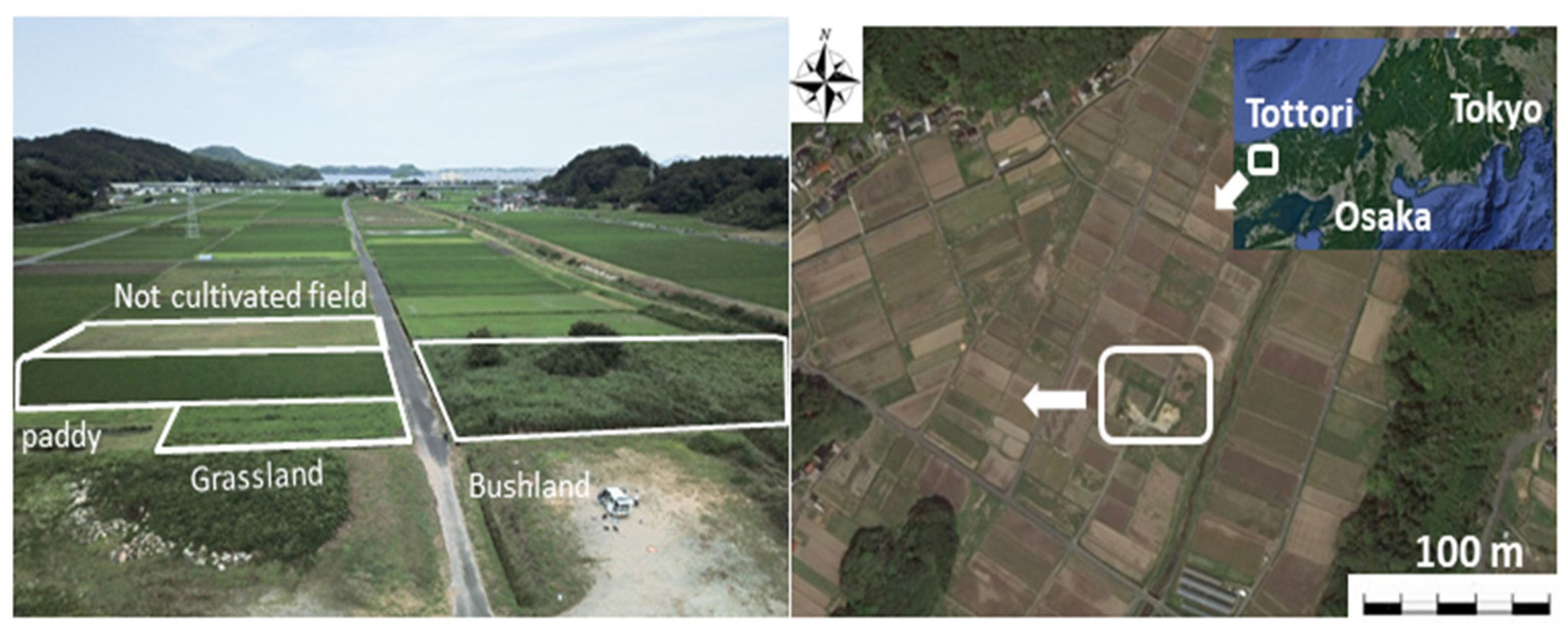
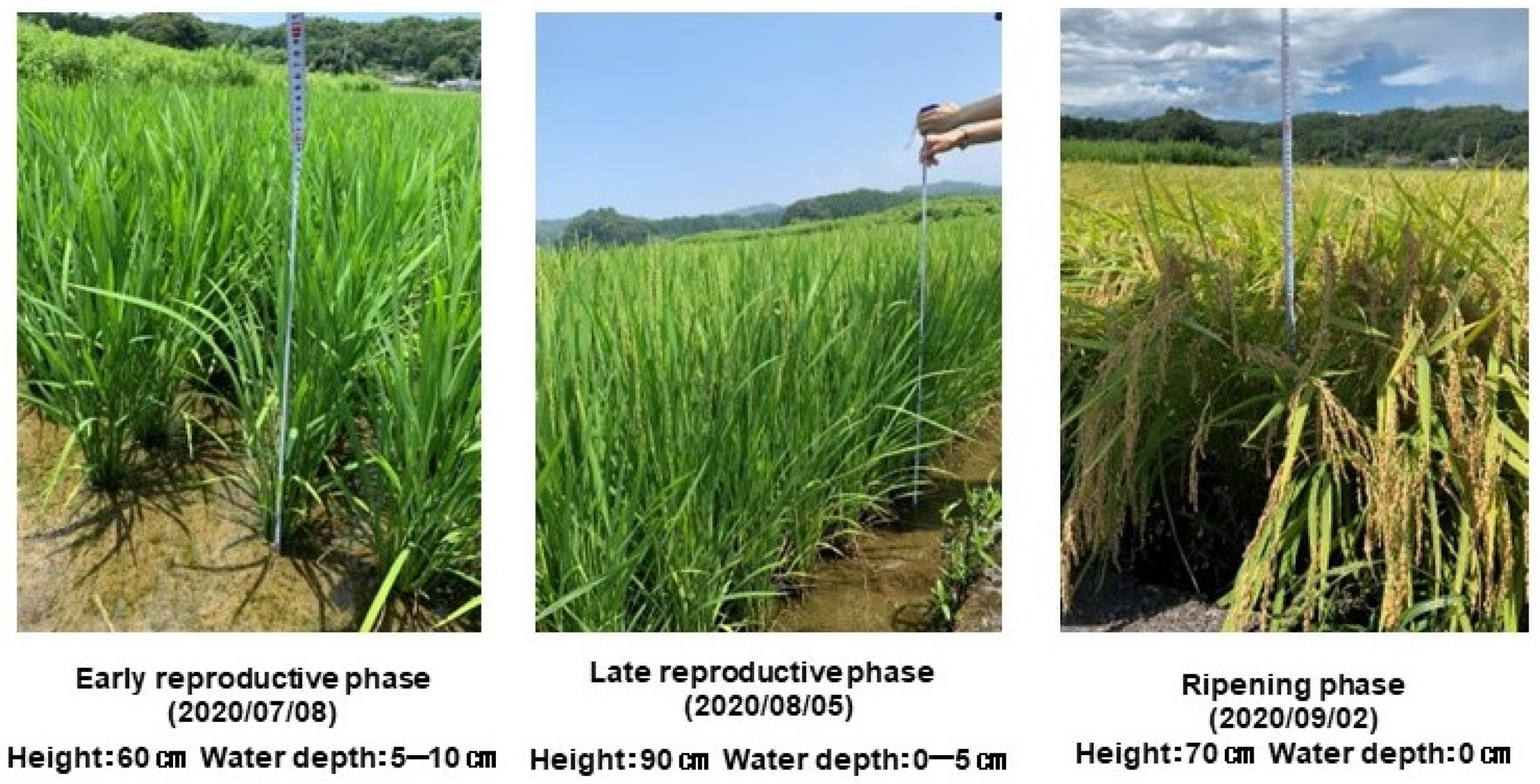
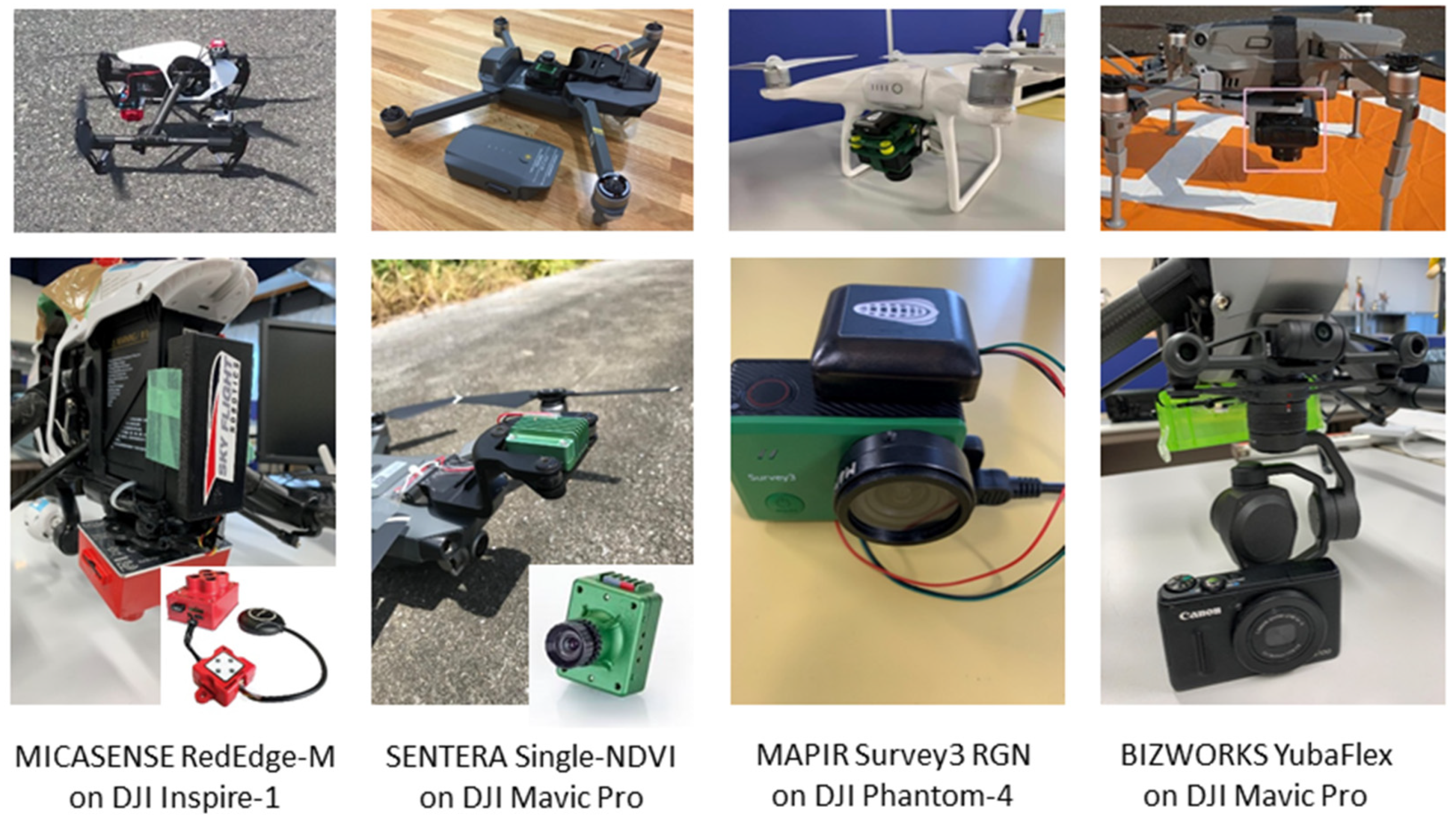
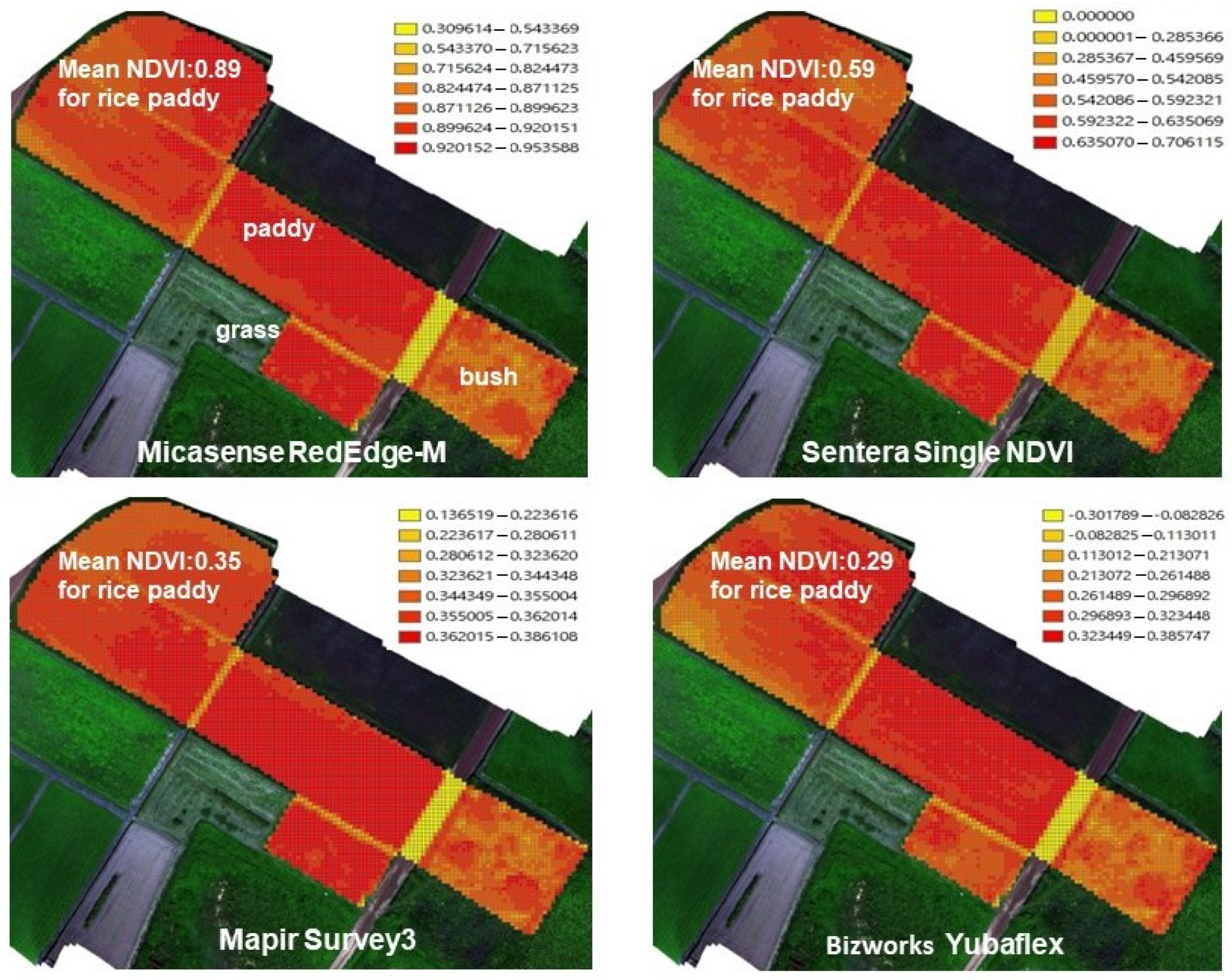
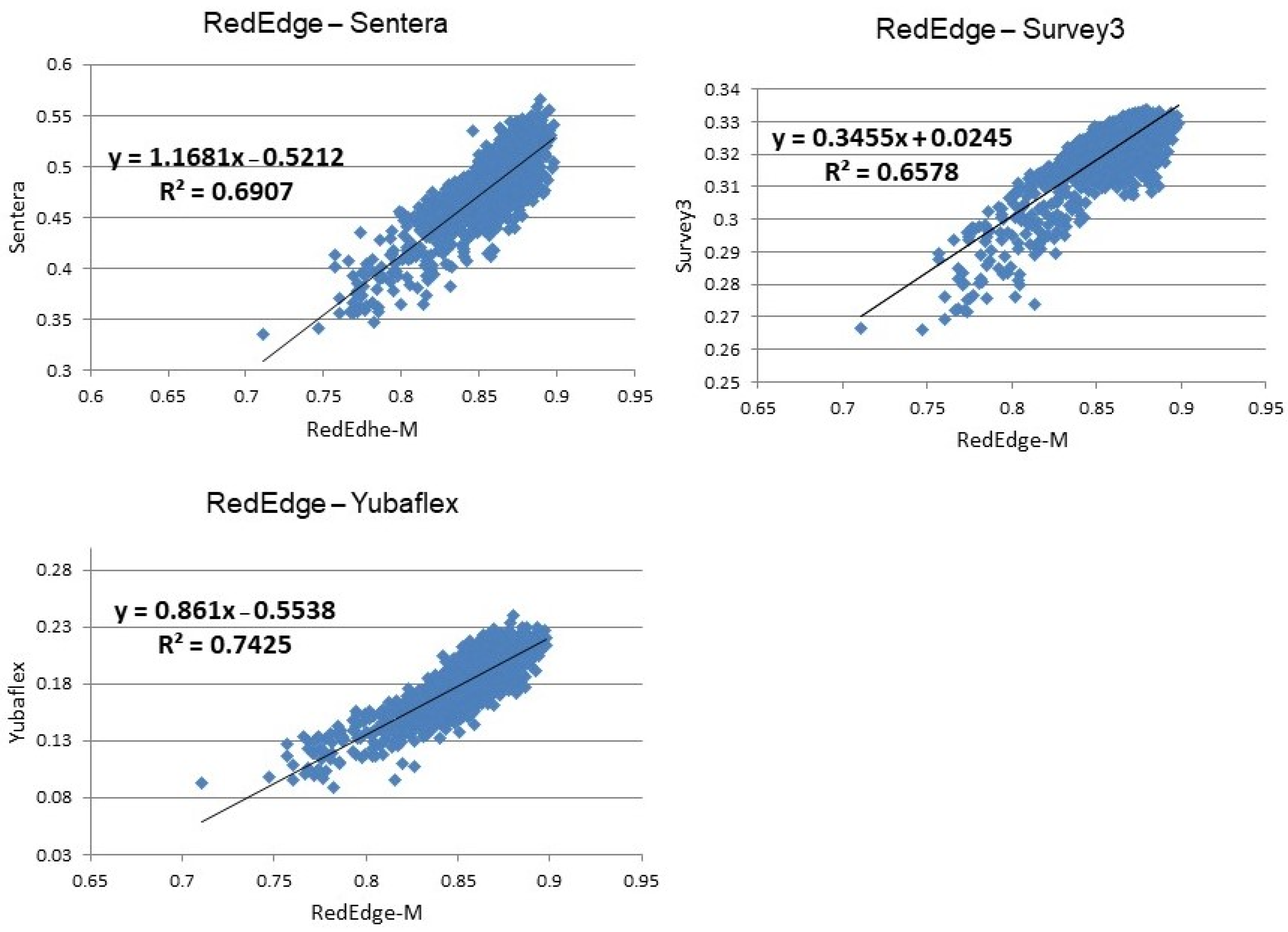
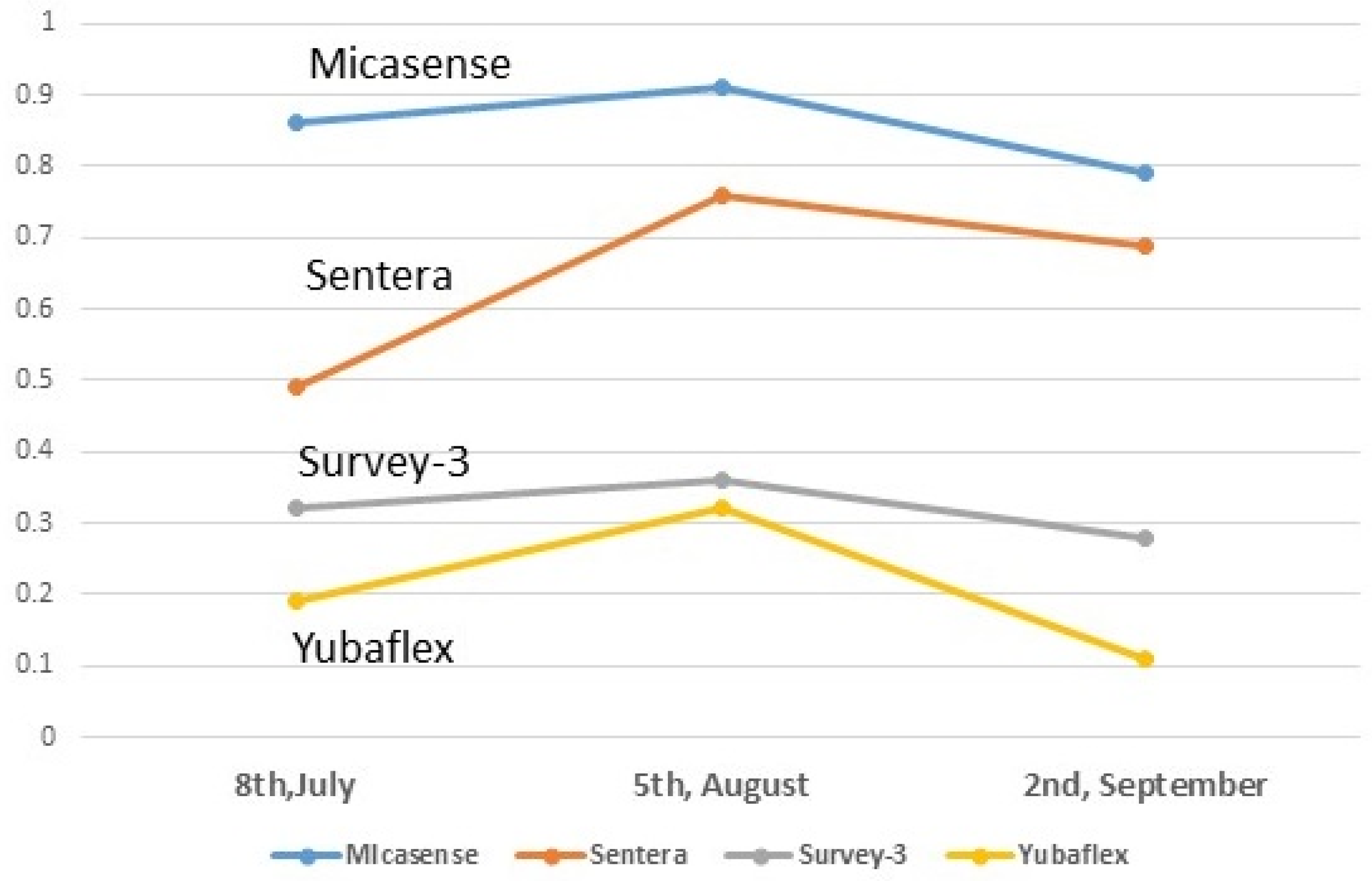
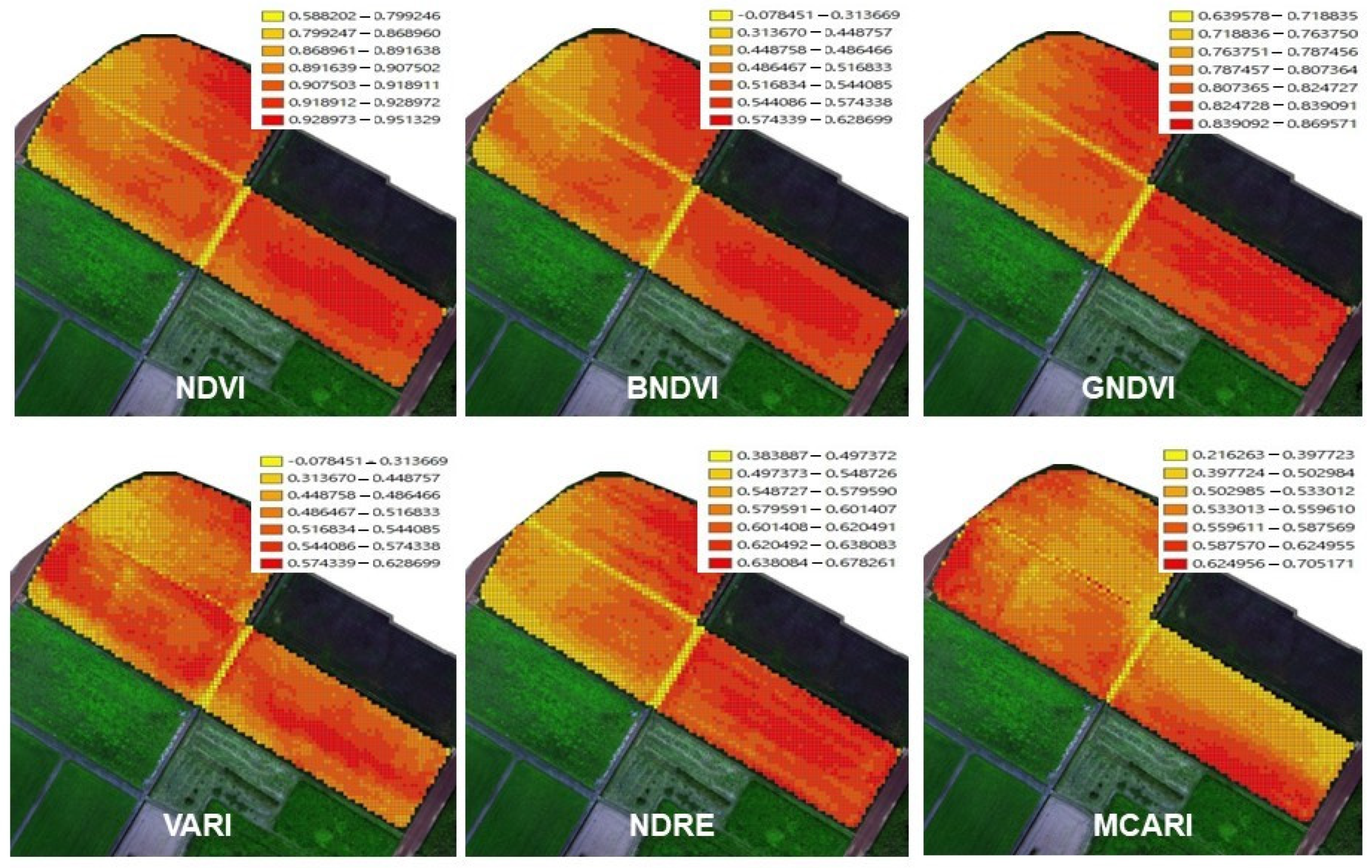

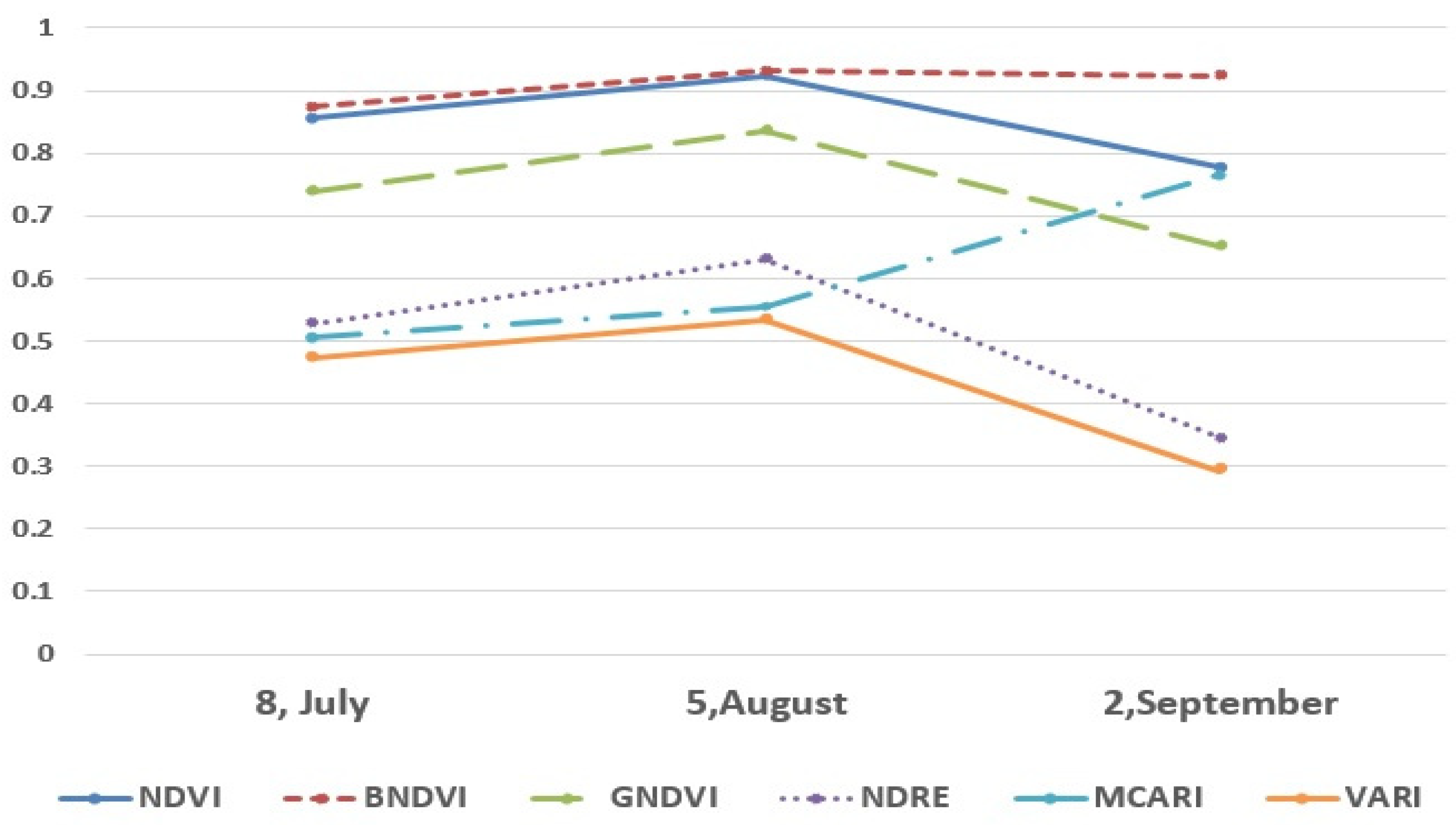
| INDEX | DESCRIPTION | FORMULA |
|---|---|---|
| BNDVI—Blue Normalized Difference Vegetation Index | NDVI index without red channel availability, for areas sensitive to chlorophyll content. | (NIR − BLUE)/(NIR + BLUE) |
| GNDVI—Green Normalized Difference Vegetation index | NDVI index without red channel availability, for areas sensitive to chlorophyll content. | (NIR − GREEN)/(NIR + GREEN) |
| MCARI—Modified Chlorophyll Absorption in Reflective Index | Index used to measure chlorophyll concentration including variations in the Leaf Area Index. | 1.2 * (2.5 * (NIR − RED) − 1.3 * (NIR − GREEN)/(normalized to the maximum value of RED, GREEN and NIR bands). |
| NDRE—Normalized Difference Vegetation Index | Index sensitive to chlorophyll content in leaves against soil background effect. This index can only be formulated when the red edge band is available. | (NIR − REDEDGE)/(NIR + REDEDGE) |
| NDVI—Normalized Different Vegetation Index | Generic index used for leaf coverage and plant health. | (NIR − RED)/(NIR + RED) |
| VARI—Visible Atmospherically Resistant Index | RGB index for leaf coverage. | (GREEN − RED)/(GREEN + RED − BLUE) |
| NDVI | BNDVI | GNDVI | VARI | NDRE | MCARI | |
| NDVI | 1 | 0.98 | 0.93 | 0.95 | 0.88 | 0.8 |
| BNDVI | 0.98 | 1 | 0.95 | 0.89 | 0.91 | 0.78 |
| GNDVI | 0.93 | 0.95 | 1 | 0.75 | 0.96 | 0.66 |
| VARI | 0.95 | 0.89 | 0.78 | 1 | 0.72 | 0.86 |
| NDRE | 0.88 | 0.91 | 0.98 | 0.72 | 1 | 0.62 |
| MCARI | 0.8 | 0.78 | 0.66 | 0.89 | 0.62 | 1 |
| (a) | ||||||
| NDVI | BNDVI | GNDVI | VARI | NDRE | MCARI | |
| NDVI | 1 | 0.99 | 0.92 | 0.93 | 0.73 | 0.57 |
| BNDVI | 0.99 | 1 | 0.91 | 0.90 | 0.69 | 0.58 |
| GNDVI | 0.92 | 0.91 | 1 | 0.78 | 0.91 | 0.32 |
| VARI | 0.93 | 0.90 | 0.78 | 1 | 0.59 | 0.69 |
| NDRE | 0.73 | 0.69 | 0.91 | 0.59 | 1 | 0.02 |
| MCARI | 0.57 | 0.58 | 0.32 | 0.69 | 0.02 | 1 |
| (b) | ||||||
| NDVI | BNDVI | GNDVI | VARI | NDRE | MCARI | |
| NDVI | 1 | 0.89 | 0.72 | 0.78 | 0.73 | 0.5 |
| BNDVI | 0.84 | 1 | 0.89 | 0.38 | 0.77 | 0.24 |
| GNDVI | 0.72 | 0.87 | 1 | 0.13 | 0.91 | 0.01 |
| VARI | 0.78 | 0.38 | 0.13 | 1 | 0.24 | 0.69 |
| NDRE | 0.73 | 0.77 | 0.91 | 0.24 | 1 | 0.01 |
| MCARI | 0.5 | 0.24 | 0.01 | 0.69 | 0.01 | 1 |
| (c) | ||||||
| Spectral Band | Micasense | Sentera | Survey 3 | Yubaflex |
|---|---|---|---|---|
| Blue | 475 nm Band width: 20 nm | - | - | - |
| Green | 560 nm Band width: 20 nm | - | 550 nm | 520~600 nm |
| Red | 668 nm Band width: 10 nm | 625 nm Band width: 100 nm | 660 nm | 600~780 nm |
| Red Edge | 717 nm Band width: 10 nm | - | - | - |
| Near Infra-red | 840 nm Band width: 40 nm | 850 nm Band width: 40 nm | 850 nm | 780~1000 nm |
Disclaimer/Publisher’s Note: The statements, opinions and data contained in all publications are solely those of the individual author(s) and contributor(s) and not of MDPI and/or the editor(s). MDPI and/or the editor(s) disclaim responsibility for any injury to people or property resulting from any ideas, methods, instructions or products referred to in the content. |
© 2023 by the authors. Licensee MDPI, Basel, Switzerland. This article is an open access article distributed under the terms and conditions of the Creative Commons Attribution (CC BY) license (https://creativecommons.org/licenses/by/4.0/).
Share and Cite
Dimyati, M.; Supriatna, S.; Nagasawa, R.; Pamungkas, F.D.; Pramayuda, R. A Comparison of Several UAV-Based Multispectral Imageries in Monitoring Rice Paddy (A Case Study in Paddy Fields in Tottori Prefecture, Japan). ISPRS Int. J. Geo-Inf. 2023, 12, 36. https://doi.org/10.3390/ijgi12020036
Dimyati M, Supriatna S, Nagasawa R, Pamungkas FD, Pramayuda R. A Comparison of Several UAV-Based Multispectral Imageries in Monitoring Rice Paddy (A Case Study in Paddy Fields in Tottori Prefecture, Japan). ISPRS International Journal of Geo-Information. 2023; 12(2):36. https://doi.org/10.3390/ijgi12020036
Chicago/Turabian StyleDimyati, Muhammad, Supriatna Supriatna, Ryota Nagasawa, Fajar Dwi Pamungkas, and Rizki Pramayuda. 2023. "A Comparison of Several UAV-Based Multispectral Imageries in Monitoring Rice Paddy (A Case Study in Paddy Fields in Tottori Prefecture, Japan)" ISPRS International Journal of Geo-Information 12, no. 2: 36. https://doi.org/10.3390/ijgi12020036
APA StyleDimyati, M., Supriatna, S., Nagasawa, R., Pamungkas, F. D., & Pramayuda, R. (2023). A Comparison of Several UAV-Based Multispectral Imageries in Monitoring Rice Paddy (A Case Study in Paddy Fields in Tottori Prefecture, Japan). ISPRS International Journal of Geo-Information, 12(2), 36. https://doi.org/10.3390/ijgi12020036







